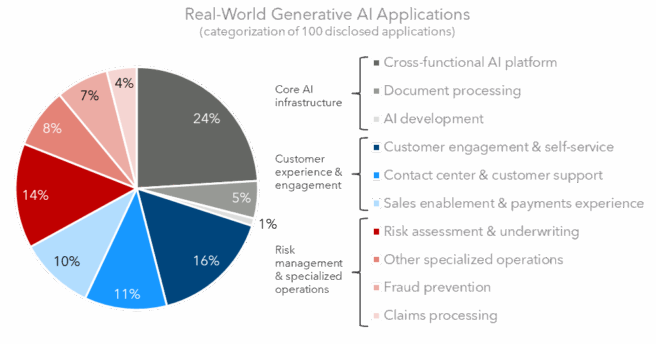[co-author: Carlos Juarez]*
Generative artificial intelligence (AI) is reshaping the financial services sector, moving from pilot projects into scaled enterprise adoption. CB Insights’ latest report addresses 100 actual applications of generative Al in financial services and insurance (the “Report”). According to the Report, banks, insurers, and wealth managers are deploying large language models (LLMs) in order to improve efficiency, personalize client interactions, and enhance risk management.

Source: CB Insights
Financial institutions are focusing on practical deployments. The Report identifies three trends: (i) embedding generative AI in front-office workflows, such as customer service and digital engagement; (ii) streamlining middle- and back-office operations, including compliance monitoring and documentation; and (iii) deploying AI-driven analytics for investment, credit, and underwriting decisions.
Banks are investing in generative AI-powered virtual assistants to handle routine client inquiries, freeing relationship managers to focus on higher-value interactions. Some banks have deployed LLMs to accelerate onboarding and loan documentation, reducing turnaround times significantly. The Report cites examples of several large banks that have:
- One launched an AI-driven contract intelligence system to accelerate loan documentation.
- Another is piloting generative AI in trade surveillance, automating monitoring for anomalies.
- Finally, a third deployed virtual assistants to manage retail customer queries, reducing call-center volumes.
Insurers are applying generative AI to claims management and underwriting. By automating claims documentation and fraud detection, companies report both cost savings and reduced cycle times. The Report provides specific examples of: an insurer that has rolled out AI-powered chatbots for policy servicing and claims updates; another that is testing generative AI to personalize policy recommendations for small business clients; and another that is using AI in claims triage, integrating generative models to process unstructured customer statements.
In wealth management, generative AI is enabling hyper-personalized advice. Asset managers are deploying AI copilots to assist advisors in tailoring recommendations, generating portfolio summaries, and monitoring client goals. Examples cited include asset managers experimenting with LLMs to synthesize market research and generate client-ready insights; a fund complex that has deployed advisor copilots that generate personalized portfolio summaries for client reviews; and a financial services enterprise that is piloting AI chat interfaces in its digital brokerage platform to guide investor decision-making.
While adoption is increasing, risks remain. CB Insights emphasizes model hallucinations, data security, and regulatory scrutiny as top challenges. Institutions are investing in “AI governance” frameworks, focusing on auditability, explainability, and compliance with emerging regulations. The Report notes some institutions have built internal “AI governance committees” to review model accuracy and compliance, and provides examples of other safeguards being implemented to mitigate risk.
*Summer Associate
[View source.]